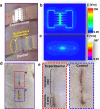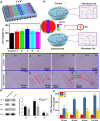Effective Wound Healing Enabled by Discrete Alternative Electric Fields from Wearable Nanogenerators
- PMID: 30488695
- PMCID: PMC6307171
- DOI: 10.1021/acsnano.8b07038
Effective Wound Healing Enabled by Discrete Alternative Electric Fields from Wearable Nanogenerators
Abstract
Skin wound healing is a major health care issue. While electric stimulations have been known for decades to be effective for facilitating skin wound recovery, practical applications are still largely limited by the clumsy electrical systems. Here, we report an efficient electrical bandage for accelerated skin wound healing. On the bandage, an alternating discrete electric field is generated by a wearable nanogenerator by converting mechanical displacement from skin movements into electricity. Rat studies demonstrated rapid closure of a full-thickness rectangular skin wound within 3 days as compared to 12 days of usual contraction-based healing processes in rodents. From in vitro studies, the accelerated skin wound healing was attributed to electric field-facilitated fibroblast migration, proliferation, and transdifferentiation. This self-powered electric-dressing modality could lead to a facile therapeutic strategy for nonhealing skin wound treatment.
Keywords: nanogenerator; physical therapy; self-powering; wearable device; wound healing.
Conflict of interest statement
The authors declare no competing financial interest.
Figures




References
Publication types
MeSH terms
Substances
Grants and funding
LinkOut - more resources
Full Text Sources
Other Literature Sources

